“A law which will give some measure of protection”: Genealogy and The Social Security Act of 1935
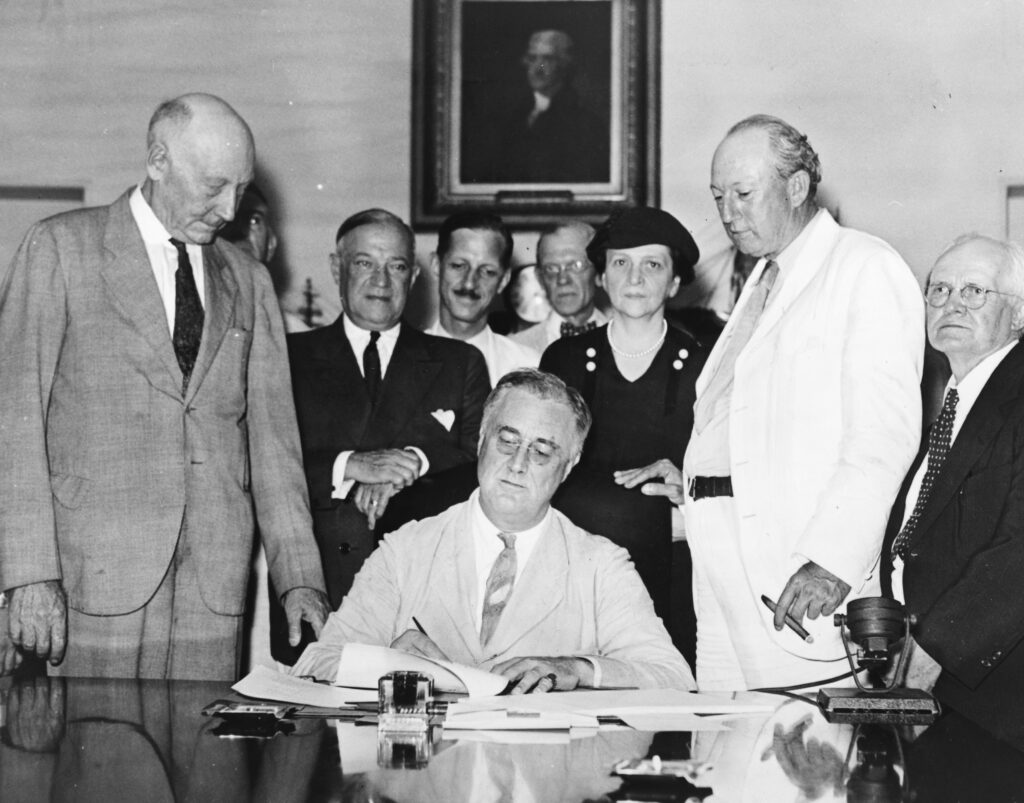
People throughout all of human history have faced uncertainties brought on by unemployment, illness, disability, death, and old age. These inevitable facets of life are said to be threats to one’s economic security. Family members and relatives have always felt some degree of responsibility to one another, and to the extent that the family had resources to draw upon, this was often a source of economic security, especially for the aged or infirm. Genealogists can benefit by knowing this history and then taking advantage of surviving records of “social insurance” generated by agencies outside of home and family.
During the Great Depression, poverty among the elderly grew dramatically. The best estimates are that in 1934 over half of the elderly in America lacked sufficient income to be self-supporting. Despite this, state welfare pensions for the elderly were practically non-existent before 1930. A spurt of pension legislation was passed in the years immediately prior to passage of the Social Security Act of 1935, so that twenty-eight states and two territories had some form of old-age pension program by 1935: Arizona, California, Colorado, Delaware, Idaho, Indiana, Iowa, Kentucky, Maine, Maryland, Massachusetts, Michigan, Minnesota, Montana, Nebraska, Nevada, New Hampshire, New Jersey, New York, North Dakota, Ohio, Oregon, Pennsylvania, Utah, Washington, West Virginia, Wisconsin, Wyoming, Alaska Territory, and Hawaii Territory. However, state programs were generally inadequate and ineffective. Only about three percent of the elderly were actually receiving benefits under these states plans, and the average benefit amount was about sixty-five cents a day.
If you had family in any of these places in the early to mid-1930s you may be able to access copies of state old-age pension records online. Indiana Memory digitized Indiana pensions issued between 1933 and 1935. The Oregon State Historical Records Index lets you search for these records and then order them online. You may also find lists of old-age pensioners in newspapers. The Greenfield Vedette and the Dade County Advocate of September 17, 1936 (available on Newspapers.com at Grapevine Library) on p. 7 printed a list of Dade Co., Missouri old-age pension recipients in various Dade Co. communities. State archives may also have various types of old-age pension records that may or may not be available for viewing.
The Social Security program that would eventually be adopted in late 1935 relied on the concept of social insurance. Social insurance was a respectable and serious intellectual tradition that began in Europe in the 19th century and was an expression of a European social welfare tradition. Social insurance coverage could be provided for a number of different types of insured conditions, from disability and death to old-age or unemployment.
So as 1934 dawned the nation was deep in the throes of the Depression. Confidence in the old institutions was shaken. The traditional sources of economic security such as assets, labor, family, and charity, had all failed in one degree or another. Radical proposals for action were springing up like weeds. President Franklin D. Roosevelt (FDR) chose the social insurance approach as the “cornerstone” of his attempts to deal with the problem of economic security.
On June 8, 1934, FDR, in a message to the Congress, announced his intention to provide a program for Social Security that would provide assistance for the unemployed, the aged, destitute children, and the physically handicapped. Subsequently, he created by Executive Order the Committee on Economic Security (CES), which was instructed to study the entire problem of economic insecurity and to make recommendations that would serve as the basis for legislative consideration by Congress.
In early January 1935, the CES made its report to the President, and on January 17 FDR introduced the report to both Houses of Congress for simultaneous consideration. The bill passed both houses on April 19 and June 19, respectively. FDR signed the Social Security Act, originally called the “Economic Security Bill,” on August 14, 1935 at 3:30 p.m. The Social Security Administration (SSA) began life as the Social Security Board (SSB). The SSB was created at the moment FDR inked his signature on the Social Security Act. In addition to several provisions for general welfare, the new Act created a social insurance program designed to pay retired workers age sixty-five or older a continuing income after retirement.
The monumental first task was to register employers and workers by January 1, 1937, when workers would begin acquiring credits toward old-age insurance benefits. Since the new Social Security Board did not have the resources available to accomplish this, they contracted with the Post Office Department to distribute the applications (Fig.1).

On June 2, 1936 the Social Security account number, which contained no significant facts about the employee other than the State of registry, was approved by the Social Security Board. The process of issuing Social Security numbers was called “enumeration.”
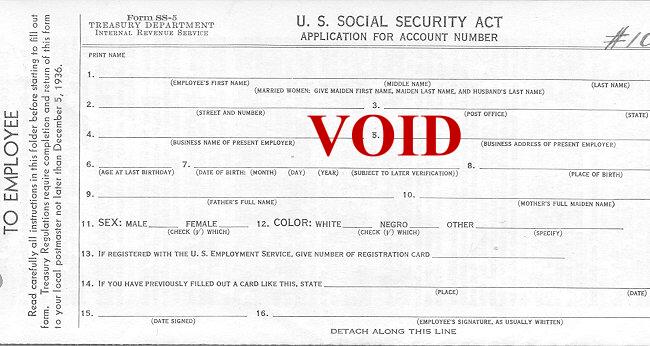
The first application forms were distributed in late November 1936. The numbers were assigned in the local post offices. The post offices collected the completed forms and turned them over to Social Security field offices located near major post office centers. The applications then were forwarded to Baltimore, Maryland, where Social Security numbers (SSNs) were registered and various employment records established. Over thirty million SSN cards were issued through this early procedure (Fig. 2). By June 30, 1937, the SSB had established 151 field offices, with the first office opening on October 14, 1936, in Austin, Texas (Fig. 3). From that point on, the Board’s local office took over the task of assigning SSNs. Thirty-six versions of the Social Security card were created between 1935 and 2022.

SSNs were intended to track the earnings that workers reported for retirement benefits. The first SSN account number record established in Baltimore was assigned to John David Sweeney, Jr. of New Rochelle, New York (Fig. 4). Although Sweeney received the first SSN account, his was not the lowest number ever issued. That distinction fell to New Hampshire resident, Grace Dorothy Owen. Ms. Owen received number 001-01-0001.

After SSNs were assigned, the first Federal Insurance Contributions Act (FICA) taxes were collected, beginning in January 1937. Special Trust Funds were created for these dedicated revenues. Benefits were then paid from the money in the Social Security Trust Funds. The original Act provided only retirement benefits, and only to the worker. In 1939 amendments accelerated the start of monthly benefit payments to January 1940 and added two new categories of benefits: payments to the spouse and children under eighteen of a retired worker (so-called dependents benefits) and survivors benefits paid to the family in the event of the premature death of a covered worker. This change transformed Social Security from a retirement program for workers into a family-based economic security program.

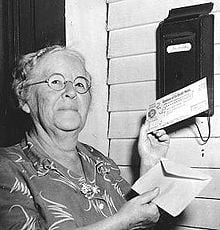
The first reported Social Security payment was to Ernest Ackerman, a Cleveland, Ohio motorman who retired only one day after Social Security began (Fig. 5). Five cents were withheld from his pay during that period, and he received a lump-sum payout of seventeen cents from Social Security. On January 31, 1940, the first monthly retirement check was issued to Ida May Fuller of Ludlow, Vermont, in the amount of $22.54 (Fig. 6). Miss Fuller, a legal secretary, retired in November 1939. She started collecting benefits in January 1940 at age sixty-five and lived to be 100 years old, dying in 1975. It was numbered 00-000-001 — the first Social Security payout.
Accessing the Records
Social Security Death Index (SSDI) 1935-2014
From a genealogical standpoint, the SSA generated valuable documents for genealogical research. One is a finding aid known as the Social Security Death Index, 1935-2014. It’s a database created from the SSA’s Death Master File of deceased individuals whose deaths were reported to the SSA. It began in 1962, when operations were computerized. It includes a few deaths from 1937-1961, about fifty percent of deceased persons from 1962-1971, and about eighty-five percent of deceased persons from 1972-2005. Very few deaths were recorded from 1937-1961.
The Index is intended to protect the benefits to beneficiaries of pension funds, insurance benefits, assist federal, state and local governments and others responsible for verifying deceased person(s) in support of fulfillment of benefits to their beneficiaries, to identify and prevent identity fraud, and identify deceased persons. In 2014 Federal legislation changed the rules for access to the Social Security Death Master File. Records for the most recent three years are not available.
The SSDI typically contains a person’s name, SSN, state issued, birth date, death date, last residence, and lump sum payment. Public versions don’t show the payment. Married women are indexed by their married name. It’s important to know that some people won’t be in the SSDI because they never worked. If someone wanted income from employment he or she had to have a SSN. Self-employed people (farmers and self-employed professionals like doctors and attorneys) didn’t qualify.
The SSDI is available to the public at subscription genealogy websites such as Ancestry.com, FindMyPast.com, Fold3.com, GenealogyBank.com, MyHeritage.com, and for free at FamilySearch.org (Fig. 7, with free login and password) and “Searching the Social Security Death Index (SSDI) in One Step” at SteveMorse.org. You can access Ancestry Library Edition and Fold3 Library Edition for free in the Genealogy Room at Grapevine Library.

Social Security Applications and Claims Index, 1936-2007
This database contains information given to the SSA through the application or claims process. It picks up where the SSDI leaves off by providing more details than the SSDI. It contains the applicant’s full name, SSN, date and place of birth, citizenship, sex, father’s name, and mother’s maiden name (Fig. 8). You might also find changes, including name changes or information on claims that were recorded. It’s available on subscription sites Ancestry.com and MyHeritage.com and for free on Ancestry Library Edition.
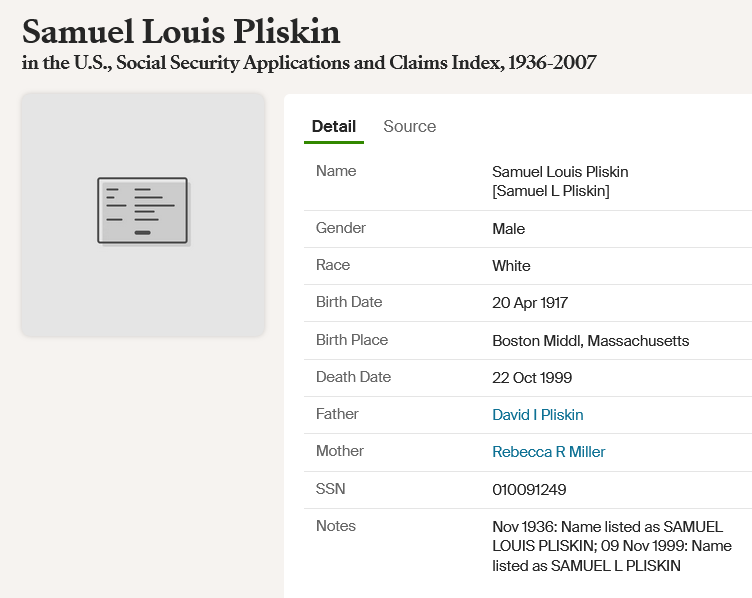
SS-5 Application
After you find your ancestor in the SSDI and the Social Security Applications and Claims Index, you can order a copy of their SS-5 application (Fig. 9). That record includes the applicant’s full name, age at last birthday, date and place of birth, father and mother’s full name (including the mother’s maiden name), gender, date signed, and applicant’s signature. The current fee for a photocopy of the SS-5 is $30 per record and $28 for the Numident. You’ll be charged the fee even if the SSA is unable to locate any information, and it may take six to ten weeks to receive the copy. If the person died within the last 120 years, you have to provide proof of death, such as an obituary or death record; otherwise, the parents’ names will be blacked out.
To order a copy of the SS-5 for a deceased person, go to this Social Security Administration web page. You can also order by mail.
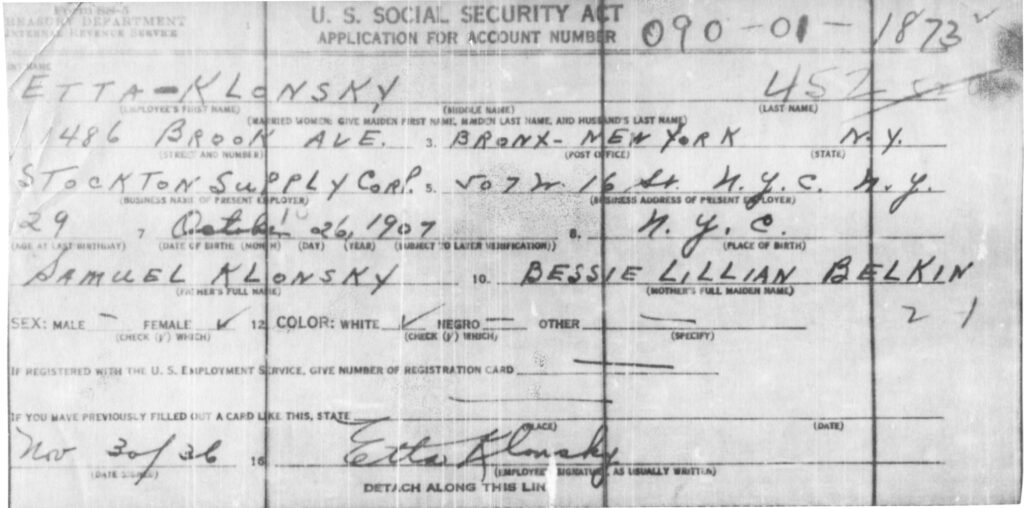
Social Security Numerical Identification Files (Numident)
The SSA’s Social Security number master file is generally known as the Numident (Numerical Index File). In 1972, SSA created an electronic file, the Numerical Index File or Numident, to house the numerically-ordered master file of all assigned SSNs. In 1973, SSA began converting its legacy SS-5 records to the Numident electronic database, completing the conversion in 1979. There is one Numident record for each SSN ever assigned (Fig. 10).
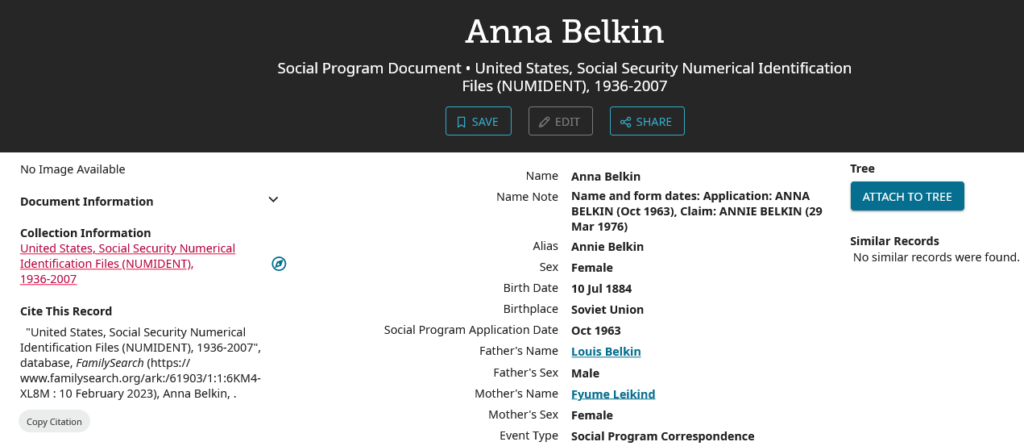
This searchable series contains one record for every Social Security number (SSN) assigned. There are three types of entries in Numident: application (SS-5), claim, and death records. To be thorough, search all three types. A Numident record may contain more than one entry. These records include each applicant’s full name, SSN, date of birth, place of birth, citizenship, sex, father’s name, mother’s maiden name, and race/ethnic description (optional). Numident includes information regarding any subsequent changes made to the applicant’s record, including name changes and life or death claims. You can search the National Archives’ Access to Archival Databases (AAD), which contains records for every Social Security number (SSN) assigned to individuals with a verified death or who would have been over 110 years old by December 31, 2007 (Fig. 11).
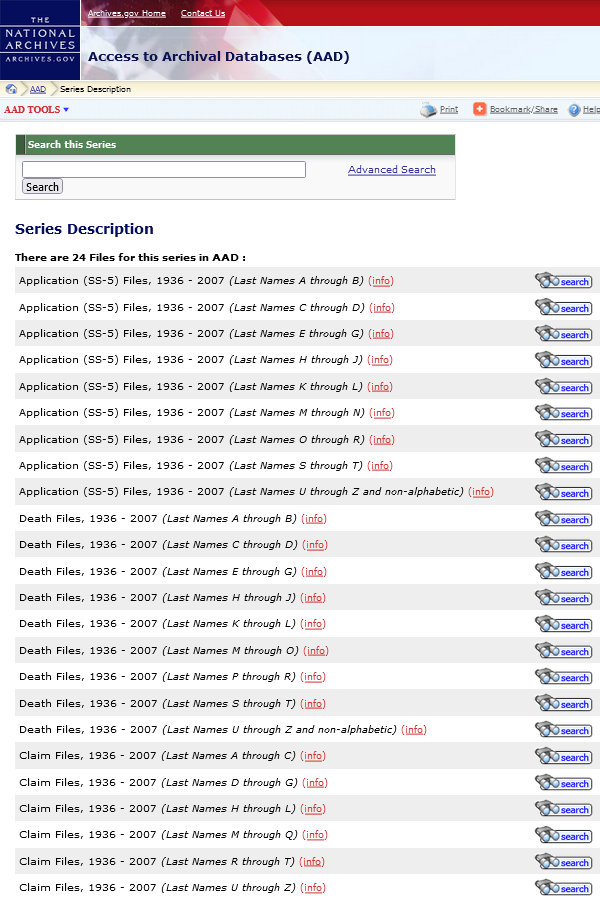
Railroad Retirement Board (RRB)
Railroads already provided benefits for their workers under the Railroad Retirement Act of 1935. A financial interchange between the Railroad Retirement and Social Security programs was established by a provision of the 1951 amendments to the Railroad Retirement Act and made retroactive to 1937. Some workers became eligible for both Social Security and Railroad Retirement Board (RRB) benefits. When that occurred, the RRB retained jurisdiction, but SSA authorized the RRB to make payment on its behalf. If a RRB recipient was eligible for, and requested, Social Security benefits, the RRB reduced its Tier I annuity to account for the Social Security benefit.
An index to over 1.5 million RRB pensions is available at the Midwest Genealogy Center web site. You can search the index by name and/or date. Names are shown by the first initial of the first name and the last name (Fig. 12). If you find the person you’re looking for, there will be two links at the bottom that allow you to print the page and submit your request to the Atlanta Branch of the National Archives, which holds the pension claims.
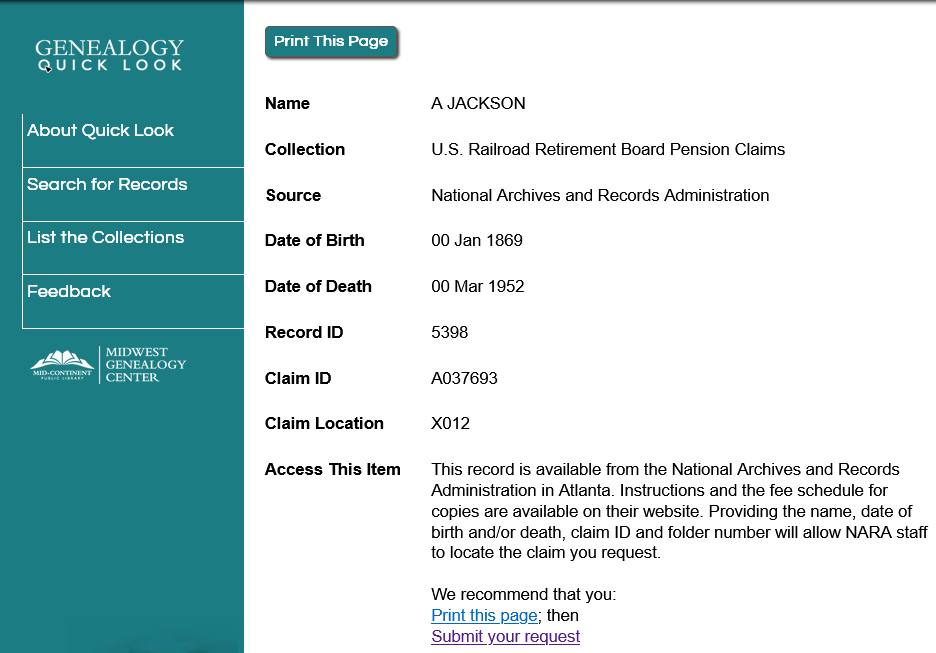
If you’d like to read some interesting and fun stories relating to Social Security numbers, such as the full story of who got the first Social Security card (and when) and who received the lowest number, and why; the SSN “dog tag” story; and the story of the most misused Social Security number in history, check out these historical Social Security Number links! If you’re really nerdy, check out ”The Story of the Social Security Number”.






Recent Comments